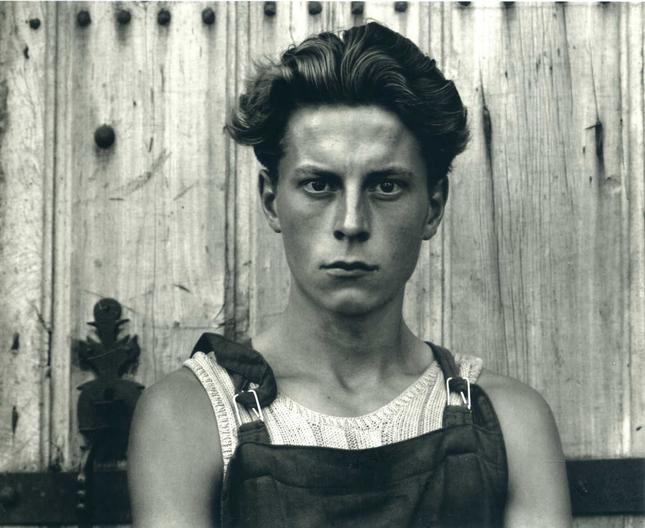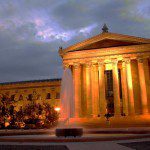Paul Strand in Philadelphia
By • October 23, 2014 0 3274

Two of the 20th century’s greatest photographers were born in 1890 and died in 1976: Man Ray and Paul Strand. Man Ray was a man of the avant-garde. His stone in Montparnasse Cemetery in Paris reads (in English): “unconcerned but not indifferent.”
Paul Strand could never be called unconcerned. He learned photography in his teens from social reformer Lewis Hine, made leftist films during the Depression and—distressed by the country’s feverish anti-Communism—moved permanently to France in 1950.
The Philadelphia Museum of Art’s new retrospective, curated by Peter Barberie, seeks to place Strand as much in the modernist camp as that mad scientist Man Ray. “Paul Strand: Master of Modern Photography,” on view through Jan. 4, deepens our understanding of modernism as it traces Strand’s six-decade career.
Two of Strand’s most famous images—“Wall Street, New York” of 1915, in which shadows stretch from tiny figures passing under the House of Morgan’s pharaonic facade; and “Blind Woman, New York” of 1916, a portrait of a peddler, her right eye half-shut, her left open and aimed farther left, the word BLIND on a sign on her chest—achieve a perfect balance of compositional power and social message.
The image of the blind woman is one of eight striking portraits hung near some of Strand’s photographic experiments with cubism, also from 1916. “Abstraction, Bowls, Twin Lakes, Connecticut,” a composition of four ceramic bowls shot close up in soft focus, is as abstract as Strand’s work ever got.
Photographer Alfred Stieglitz showed Strand’s work at 291, his Fifth Avenue gallery, and published it in his journal, “Camera Work.” Several paintings by other members of the Stieglitz circle—Arthur Dove, Marsden Hartley, John Marin and Georgia O’Keeffe—are included in the show. (O’Keeffe, who married Stieglitz in 1924, was also a romantic interest of Strand’s. Stieglitz was more than 20 years her senior and Strand was three years her junior.)
In 1922, Strand married Rebecca Salsbury and purchased a hand-cranked Akeley motion picture camera. Perhaps representing the two sides of the photographer’s aesthetic, five tight close-ups of each—woman and camera—are displayed on one wall.
In the early 1930s, having separated from both his wife and his mentor Stieglitz, Strand moved to Mexico for two years, drawn by the socialist government and related artistic activity. He photographed people in town squares, among other subjects then dropped still photography to make films.
One of the exhibition’s two screening rooms presents a nine-minute segment from “Redes,” his 1936 film about a fictional Mexican fishing village, alternating with a segment from “Native Land,” his documentary about union busting, released in 1942.
Several galleries are devoted to Strand’s travels, which resulted in a number of collaborative “portraits of place.” Three that became books receive special attention: “Time in New England”; “Un Paese: Portrait of an Italian Village,” about Luzzara, the hometown of Cesare Zavattini, screenwriter of the Vittorio De Sica film “The Bicycle Thief”; and “Ghana: An African Portrait.”
The three books, none still in print, have been digitized for browsing on computer kiosks.
The last decades of Strand’s life were spent in France. He and his third wife, photographer Hazel Kingsbury, bought a house in Orgeval outside of Paris. The closing section of the exhibition shows photographs of the Strands in their garden and several of the still lifes of plants he grew there.
“Paul Strand: Master of Modern Photography” is one of several good reasons for a trip to Philadelphia, also the home of the Barnes Foundation, the Pennsylvania Academy of the Fine Arts and the Institute of Contemporary Art.
Upcoming auctions at Freeman’s, the oldest American auction house, include Modern & Contemporary Works of Art (Nov. 2), Jewelry & Watches (Nov. 3), American Furniture, Folk & Decorative Arts (Nov. 13) and American Art & Pennsylvania Impressionists (Dec. 7).
Among the leading Philadelphia art galleries are Schwarz Gallery, next to Freeman’s on Chestnut Street, specializing in 19th- and early 20th-century paintings; Newman Galleries on Walnut Street, showing paintings by Eakins student Fred Wagner (Nov. 1-Dec. 31, reception Nov. 14); and contemporary gallery Locks Gallery on Washington Square, presenting “Thomas Chimes: The Body in Spirals” (Nov. 7-Dec. 13).
- “Jeune Garcon, Charente, 1951” by Paul Strand



